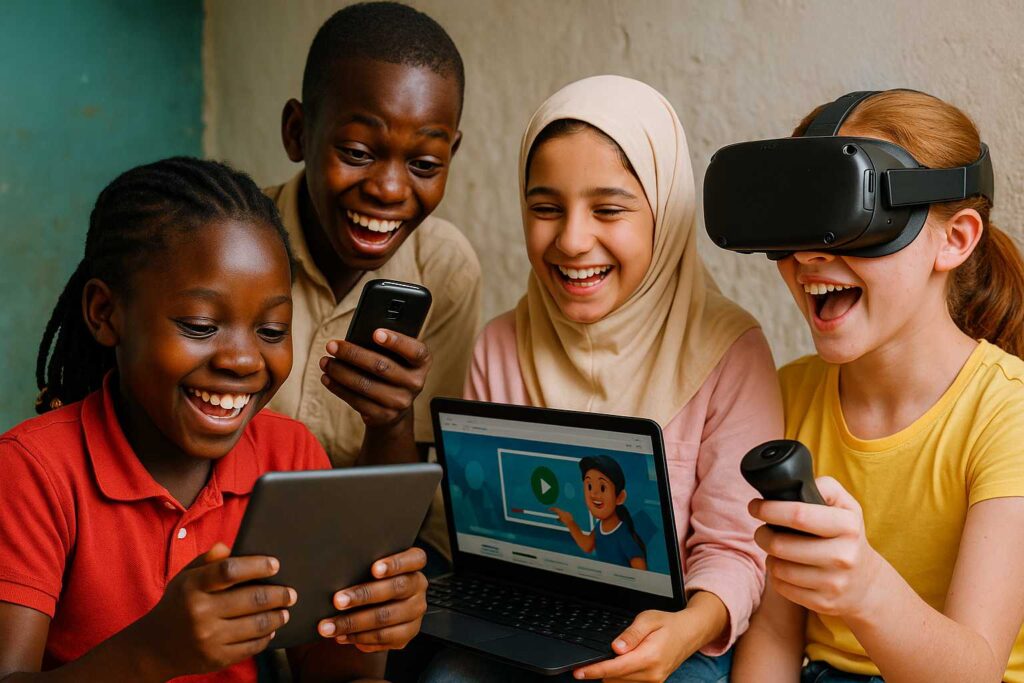Why This Matters in 2025
“Digital classroom.” “Virtual reality in education.” These aren’t buzzwords; they’re the new baseline. Yet parents and teachers still ask a hard question: Will technology truly level the playing field, or only help students who are already ahead?
This article tackles the optimistic side – real-world EdTech programs that have narrowed gaps in geography, gender, disability, and funding. Each example is backed by data or case studies cited in our previous research notes.
1. Khan Academy — Free, Multilingual, Offline-Ready
-
What’s equalized: High-quality math and science instruction
-
Key study: Government schools in India reported a 38 % jump in foundational-math mastery after adopting downloaded Khan videos and quizzes
-
Why it works: Always-free content, dozens of languages, and offline packages for schools without stable internet. No subscription means no paywall.
2. Eneza Education — Pocket-Sized Tutoring on Basic Phones
-
What’s equalized: Rural access to curriculum-aligned practice
-
Key data: Over 6 million Kenyan, Ghanaian, and Ivorian learners use SMS/USSD lessons for about $0.10 a week; independent evaluations show higher exam scores and lower dropout rates.
-
Tech note: No smartphone, no Wi-Fi—just text messages that reach the most remote villages.
![]()
3. Virtual Labs in Underserved Schools — Science Without the Lab Budget
-
What’s equalized: Hands-on experiments for schools lacking equipment
-
Case highlight: A South African rural-school project found students using VR chemistry simulations matched urban peers on lab assessments despite zero physical glassware
-
Accessibility win: One student with no arms completed biology labs independently via adapted VR controls—impossible in a traditional lab.
XReady Lab follows this model with curriculum-aligned VR biology and VR chemistry simulations that run on affordable headsets and require no dangerous chemicals or expensive gear.

4. UNICEF & Microsoft Learning Passport — School in a Box for Refugees
-
What’s equalized: Continuous education for displaced children
-
Impact metric: More than 2 million refugee learners access math, language, and psychosocial resources offline via rugged tablets
-
Why it matters: When war or disaster shuts down brick-and-mortar schools, an offline-capable app keeps learning on track.
5. Technovation — Closing the Gender Gap in Global STEM
-
What’s equalized: Girls’ access to coding skills and mentors
-
Program reach: 150 000+ girls in 100 countries have built mobile apps to solve local problems and gained confidence to pursue tech degrees
-
Digital edge: Remote video mentoring links girls to female role models they’d never meet locally—an online boost for real-world equity.

What Makes These Wins Possible?
-
Low or zero cost — free licenses, text-based pricing, or donor funding slash paywalls.
-
Offline or low-bandwidth modes — content downloads, SMS delivery, and lightweight VR run where broadband is spotty.
-
Inclusive design — screen-reader compatibility, adjustable controls, and multilingual content put learners with disabilities or language barriers on equal footing.
-
Curriculum alignment — national-standard lessons ensure tech supplements, not sidetracks, classroom goals.
Open Questions for Educators and Policymakers
-
How can we fund universal device access so every student can join digital lessons?
-
What teacher-training models best support low-income schools adopting VR learning?
-
Can public agencies bulk-license premium apps to prevent a two-tier digital system?
Conclusion — Technology Is a Tool; Equity Is a Design Choice
These five programs prove EdTech can expand inclusion when affordability, accessibility, and relevance drive deployment. They show a path forward for virtual reality in education, mobile micro-learning, and open-content platforms to lift the learners who need them most.
But the story isn’t finished. In our upcoming follow-up article, we’ll explore how the same innovations can reinforce inequality—and what it takes to avoid that fate.



